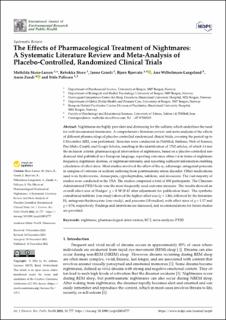| dc.description.abstract | Nightmares are highly prevalent and distressing for the sufferer, which underlines the need for well-documented treatments. A comprehensive literature review and meta-analysis of the effects of different pharmacological placebo-controlled randomized clinical trials, covering the period up to 1 December 2022, was performed. Searches were conducted in PubMed, Embase, Web of Science, PsychInfo, Cinahl, and Google Scholar, resulting in the identification of 1762 articles, of which 14 met the inclusion criteria: pharmacological intervention of nightmares, based on a placebo-controlled randomized trial published in a European language, reporting outcomes either/or in terms of nightmare frequency, nightmare distress, or nightmare intensity, and reporting sufficient information enabling calculation of effect sizes. Most studies involved the effect of the α1-adrenergic antagonist prazosin in samples of veterans or soldiers suffering from posttraumatic stress disorder. Other medications used were hydroxyzine, clonazepam, cyproheptadine, nabilone, and doxazosin. The vast majority of studies were conducted in the USA. The studies comprised a total of 830 participants. The Clinician-Administered PTSD Scale was the most frequently used outcome measure. The results showed an overall effect size of Hedges’ g = 0.50 (0.42 after adjustment for publication bias). The synthetic cannabinoid nabilone (one study) showed the highest effect size (g = 1.86), followed by the histamine H1-antagonist hydroxyzine (one study), and prazosin (10 studies), with effect sizes of g = 1.17 and g = 0.54, respectively. Findings and limitations are discussed, and recommendations for future studies are provided. | en_US |

